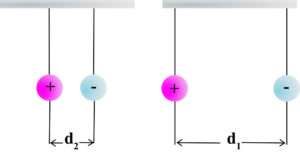Exercises
Exercise 1. Consider the two oppositely charged spheres hanging from strings in the figure below:
In the figure, the spheres are separated by a distance d1. The spheres are moved further apart to a distance d2.
a) What is the effect on the potential energy when the spheres are moved?
As the particles are moved apart, the potential energy becomes more positive because of the increase in distance, d.
b) What effect does this have on ΔE?
ΔE will become positive as the particles are moved apart. The internal energy of the system undergoes and increase.
c) Comment on q and w for this process.
The work is done on the system in order to separate the oppositely charged particles and w is positive. Nothing is known about q, but we do know that ΔE = q + w, and ΔE is positive, so q could not be large and negative.
Back to State Functions and PV Work
Exercise 2.Calculate the amount of work, in J, in a chemical reaction, if the volume increases from 5.00 L to 10.6 L against an external pressure of 4.5 atm. What is the sign of w?
w = -PΔV
ΔV = 10.6 L – 5.00 L = 5.6 L
w = -4.5 atm x 5.6 L = -25.2 atm⋅L
\(\displaystyle -25.2\;atm⋅L\times\frac{101\;J}{1\;atm⋅L}\;=\;\mathbf{-2.54\;x\;10^3\;J}\)
Work has been done by the system on the surroundings. The sign of w is negative.
Back to State Functions and PV Work
Exercise 3. A Big Mac has a nutritional content of 540. Cal (1 Cal = 1000 calories). If this energy could be used to light a 100 W (1 W = 1 J/s) incandescent bulb, how many hours would the bulb stay lit?
The Big Mac has 5.40 x 105 calories. First convert calories to J.
\(\displaystyle 5.40\;\times\;10^5\;calories\times\frac{4.184\;J}{calorie}\;=\;2.26\times\;10^6\;J\)1 W = 1J/s The light bulb will need 100 J/s.
\(\displaystyle 2.26\times\;10^6\;J\times\frac{s}{100\;J}\times\frac{1\;hr}{3600\;s}\;=\;\mathbf{6.28\;hr}\)
Back to State Functions and PV Work
Exercise 4. The combustion of one mole of methane will release 2043.0 kJ of heat. If 7.65 g of propane is reacted, and the volume change is -1.95 L at 1.00 atm of pressure, how much PV work, in kJ, is done? What is ΔE, in kJ?
First, write the chemical equation for the combustion of propane.
C3H8 (g) + 5 O2 (g) → 3 CO2 (g) + 4 H2O (g)
w = -PΔV = – 1.00 atm x -1.95 L = 1.95 L⋅atm
\(\displaystyle w\;=\;1.95\;L⋅atm\times\frac{101\;J}{1\;L⋅atm}\;=\;197\;J\;=\mathbf{0.197\;kJ}\)
Next, convert the 7.65 g of propane to moles of propane. The molar mass of propane is 44.1 g/mol
\(\displaystyle 7.65\;g\times\frac{1\;mol}{44.1\;g}\;=\;0.173\;mol\;propane\)
It is stated in the problem that 2043.0 kJ of heat is evolved if one mole of propane is reacted. We need to calculate the heat released when 0.173 moles of propane is reacted.
\(\displaystyle 0.173\;mol\times\frac{2043.0\;kJ}{1\;mol}\;=\;353.0\;kJ\)
Now, calculate ΔE
ΔE = q + w = -353.0 kJ + 0.197 kJ = -352.8 kJ
Note, the amount of work done is small compared to the amount of heat released.

